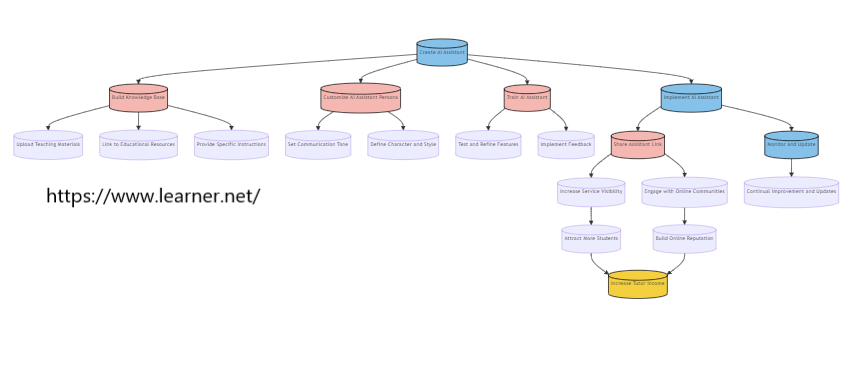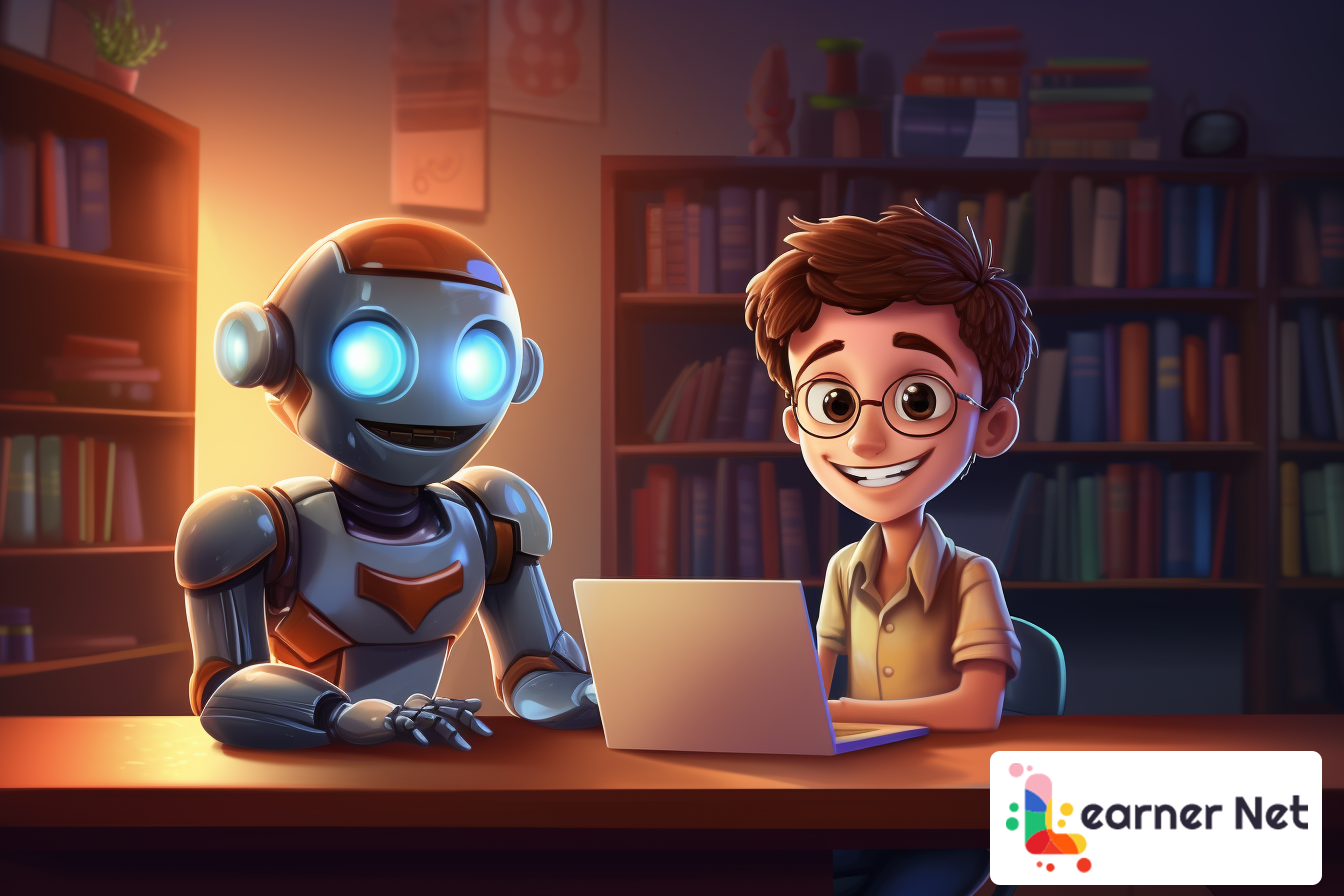Learner Net is currently launching a free, programmable AI Assistant Builder as an intelligent software application designed to simulate conversation with users. Unlike traditional chatbots that follow predefined scripts, programmable AI Assistants are dynamic and can be customized or programmed to suit the specific needs of tutors, teachers, and even for students as the technology and training progress.
The Learner Net AI Assistants are powered by advanced natural language processing (NLP) and machine learning algorithms, allowing them to understand user inputs and respond in a way that feels natural and human-like. The versatility of programmable the AI Assistants makes them invaluable in various professional settings, especially for online teachers and tutors.
In the ever-expanding world of distance learning and online education, the Learner Net AI Assistant serves as a versatile, virtual assistant, streamlining various tasks to enhance the overall teaching experience for Learner Net tutors. There is a much more comprehensive article about the benefits of the future of learning, and navigating the intersection of AI and social learning at Learner Net. There are also additional resources there for any online tutors who have wanted or who may want to learn more about incorporating AI into their online lessons and tutoring options.
Programmable AI Assistants can be programmed to:
Provide Instant Support: Teachers can utilize chatbots to instantly address common queries from students, saving time and ensuring a prompt response.
Automate Routine Tasks: Chatbots can automate administrative tasks such as scheduling, sending reminders, and providing links to learning resources, allowing teachers to focus more on actual teaching.
Assist with Grading: For assignments or quizzes with straightforward answers, the AI Assistant can assist in grading, providing quicker feedback to students. Additional training may be required, but there is the potential for much broader grading options with the proper input into the Knowledge base for the AI Assistant.
Deliver Personalized Learning: By analyzing individual student performance and preferences, the AI Assistant can suggest tailored learning materials, adapting to each student’s unique needs.
Facilitate Communication: The AI Assistant can streamline communication between students and teachers, creating a centralized platform for announcements, discussions, and feedback.
Language Learning Support: For language tutors, the AI Assistant can provide conversational practice, vocabulary quizzes, and grammar explanations.
Interactive Interface for Students: For students, the AI Assistant can be an equally powerful tool, and when given the proper knowledge base to work from, can provide a unique, interactive online experience for the students of tutors, giving the online teachers an edge over much of their online competition.
In the rapidly evolving landscape of online education, where the demand for teachers has never been higher, the programmable AI Assistant Builder is very likely to emerge as an indispensable tool for online tutors. They not only enhance the efficiency of educational processes but also contribute to a more engaging and personalized learning experience for students. The ability to adapt and customize the AI Assistant makes them particularly fitting for the diverse and dynamic requirements of teachers and tutors navigating the challenges of online education.
The Benefits Of AI Assistants For Tutors
Instant support is critical in the online learning environment where students may encounter challenges or have questions in real-time. The AI Assistant can swiftly address common queries, providing immediate assistance. This efficiency not only enhances the overall learning experience but also contributes to the teacher’s reputation for responsiveness, making them more appealing to students seeking timely assistance.
Automation of routine tasks is a game-changer for online teachers. By delegating administrative responsibilities to the AI Assistant, teachers can free up valuable time to focus on the core aspects of teaching. This streamlined approach not only improves efficiency but also allows teachers to take on more students without compromising the quality of their teaching, potentially increasing their overall income.
Grading is a time-consuming task for educators. The AI Assistant can be taught to assist in grading assignments or quizzes with straightforward answers, significantly reducing the time and effort teachers spend on this repetitive task. This efficiency not only allows teachers to provide quicker feedback to students but also enables them to take on a higher volume of assignments, attracting more students who appreciate timely assessments.
Personalized learning experiences are highly sought after by students. The AI Assistant, equipped with the necessary training and knowledge to analyze individual student performance and preferences, can suggest tailored learning materials. This customization caters to each student’s unique needs, making the learning experience more engaging and effective. The ability to offer personalized learning is a significant draw for students, enhancing the teacher’s popularity and attracting more learners.
Effective communication is key to successful online teaching. The AI Assistant can be used to create a centralized platform for announcements, discussions, and feedback. This centralized communication hub fosters a sense of community in the virtual classroom, enhancing the overall learning environment. Teachers who utilize the AI Assistant Builder for efficient communication are likely to attract more students who value clear and organized interaction.
For language tutors, the AI Assistant offers invaluable support. They can provide conversational practice, vocabulary quizzes, and grammar explanations, supplementing the teacher’s lessons. This comprehensive language learning experience not only adds value for students but also positions the language tutor as a resourceful and innovative educator, increasing their popularity among language learners.
The AI Assistant interactive interface serves as a powerful tool potentially for both teachers and students. By providing a unique and engaging online experience, teachers can differentiate themselves from their online competition. The interactive interface can be used to create a dynamic learning environment, making the online tutor more popular among students who seek innovative and interactive teaching methods. This popularity can lead to increased student enrollment, thereby boosting the tutor’s income and success in the competitive online education landscape.
Leveraging AI Assistants to Increase Tutor Income
Online tutors can strategically leverage the programmable AI Assistant Builder to enhance their advertising and marketing efforts and attract a larger student base. To start, tutors can emphasize the AI Assistant’s unique features in promotional materials and on their tutoring platforms. By showcasing how the assistant provides personalized learning experiences, quick support, and efficient grading, tutors can communicate the distinct advantages of their services.
Creating informative and engaging content is essential. Tutors can develop blog posts, articles, or video content that highlights the AI Assistant’s impact on the learning journey. Real-life success stories and case studies can be woven into this content to build credibility and demonstrate the tangible benefits of integrating the AI Assistant into the tutoring experience.
Social media platforms offer a dynamic space for promotion. Tutors can use the many different social media channels and platforms to share snippets of the AI Assistant Builder in action, conduct live demonstrations, and actively participate in relevant online communities. Encouraging current students to share their positive experiences on social media can amplify the reach and effectiveness of the advertising campaign.
Collaboration with influencers or respected figures in the education sector can elevate the tutor’s profile at the same time it increases their online “status” and credibility. These influencers can provide testimonials, share their positive experiences with the AI Assistant, and introduce the tutor’s services to a broader audience.
Paid advertising campaigns, especially on platforms like Google Ads and social media, can effectively target potential students actively searching for online learning solutions. The advertising content should highlight the AI Assistant’s features and emphasize how it enhances the overall learning experience.
To create a sense of urgency and incentivize enrollment, tutors can offer special promotions or discounts for students who sign up for their services, incorporating the AI Assistant. Limited-time offers can drive interest and prompt potential students to take immediate action.
Finally, the tutor’s website and landing pages should be optimized to clearly communicate the benefits of the AI Assistant Builder and the AI Assistant. Engaging visuals, compelling language, and a user-friendly interface can contribute to a positive first impression, encouraging visitors to explore the tutor’s offerings.
By integrating these strategies, tutors can effectively market their online teaching services, leveraging the programmable AI Assistant Builder as a key differentiator. The emphasis on personalization, efficiency, and positive learning outcomes will contribute to increased student applications and overall success in the competitive online education landscape.
Diagram 1: The AI Assistant Builder Process for Online Tutors

How To Use The AI Assistant Builder
The first step for the online tutor who wishes to create their very own AI assistant is to sign in to the Learner Net website and to create an account if they do not already have one. It is one hundred percent free to use the basic functions of the AI Assistant Builder. More advanced features are readily available for those whose desire is to have as many tools at their disposable as possible.
Once the individual has created the Learner Net account, they can go to the dropdown menu as indicated in the illustration here, and from there, click on the option to Create/Edit AI assistant. This will take the user to the page where they will create, build, test, and revise the AI assistant. Testing and revisions are likely to continue as the creators grow more accustomed to working with it, and seek to enhance its abilities to assist both tutors and their students.
The first thing that needs to be done, is to create a name for the AI Assistant. This option is strictly up to the decision of the individual. Some people will go for cute and clever names while others may wish to remain more serious in their approach. The name should however, give at least some indication of what the AI Assistant is, and its functions, especially if there will be any interaction between the students and the AI Assistant.
The First section or Knowledge Base Section for the AI Assistant Builder will look like this:Upload documents that encapsulate your teaching materials, methodologies, and subject expertise. Accepted formats include PDF, DOCX, TXT, CSV, JSON, JSONL and SRT formats, with max size of 8MB. These documents will serve as the foundational knowledge base for your AI Assistant, enabling it to provide accurate and relevant educational support. |
It may be best to stick with the text format for one simple reason. As the abilities and responsibilities of the AI Assistant increase, and the instructions or parameters it must follow accordingly, in addition to the knowledge it must have, documents created with word processors will take up more space. Text files are consistently small. There are some individual tutors who may wish to use the programming options available however, as they may wish to program more attributes rather than leaving them as simpler and less viable parameters for the operation of the AI Assistant.
The Second Section or Knowledge URL Section for the AI Assistant Builder will look like this:Link to online educational resources, articles, or your own published content that aligns with your teaching subjects. This additional information will enhance your AI Assistant’s knowledge base, ensuring it is well-rounded and comprehensive |
For those tutors that do have a website, it may be beneficial to use this section. However, there is not going to be any single URL that contains the whole of mathematics, or even a single course of math such as a comprehensive compilation of everything necessary to teach geometry for example. That is not to say that the option is not viable for everyone, merely that using this alone would result in a very limited capacity of the AI Assistant to perform to its full potential.
For those online tutors who do not have a website, even a free website will work fine, and it may help to create a more complete instruction manual or knowledge base for the AI assistant in that fashion. Even with most free websites, there will not likely be 8MB restrictions such as there are with the document uploads. It is also important to note that the knowledge base is going to continually grow, expand, change, and otherwise be inconsistent, especially in the earlier days while the AI Assistant is in the learning stage of its functional parameters.
The utilization of a single URL to post all the relevant instructions should give the online tutors an easy method for making both large and small changes during the testing process, and to examine the results to determine which are more desirable and which interfere with the successful operations of the AI Assistant.
The Third Section or Knowledge Instructions Section for the AI Assistant Builder will look like this:Provide specific instructions or highlight key areas of focus to guide your AI Assistant in utilizing the knowledge from the documents and URL. This could include prioritizing certain topics, emphasizing specific teaching methods, or aligning with curriculum standards. |
This third section includes a (limited) WYSIWYG editor to allow the user to instruct the AI Assistant inside the builder, and to give it specific instructions for how to utilize the Knowledge Base Documents and/or the Knowledge Base URL. This is both beneficial and potentially troublesome, but is a powerful tool, though it may require some testing before its functions are more fully understood.
It should be noted that the system in its present iteration has been created and implemented in a method designed to make it easy to use even for someone who has absolutely no programming experience, or even any experience with Machine Learning or other related technological advances. Thus, this same ability to incorporate a more expansive knowledge base and more specific instructions is a powerful tool, but may make testing and perfecting the AI assistant a little more difficult for some people who may not have an exact idea of what they want to accomplish with their AI assistant.
It may be beneficial to carefully consider the reasons behind the AI Assistant, and to create a flow chart or schematic outlining exactly what needs to be done in order for the LearnerNet AI Assistant to function as desired. The ability to visualize how and where the AI Assistant has to look to provide any particular action desired may make it easier, even for the less technically inclined online tutors to determine a proper path for their AI Assistant to follow.
The Fourth Section or Persona Instructions Section for the AI Assistant Builder will look like this:Define the character, tone, and communication style of your AI Assistant. Detail how it should interact with students, ensuring it aligns with your teaching style and creates a supportive and positive learning environment. |
In the interest of Full Disclosure, it may be interesting to note that this is the favorite section of the author, as it is where the actual “personality” (programmed or not) of the AI Assistant will be created. Here it is possible to “create” anyone from Albert Einstein to Helen Keller to Socrates to assist both the tutor and the students. However, if there are no personality traits input, the responses are likely to read like the came off virtually page on the internet.
Should an online tutor wish to have a carbon copy of themselves as their AI Assistant, they can enter their own personality traits here, common phrases that they use, and any other idiosyncrasies and personality traits that they wish to implement. What were the personality traits of Einstein? Keller? Socrates? This is one of those places the individual tutor can greatly enhance the capacity for their AI Assistant to interact in both a unique and memorable way.
This section also has the same WYSIWYG editor, allowing for easily changing the persona even as testing and implementation of the AI Assistant continue. The testing phase will be imperative, but for better or worse, each and every use case scenario will be unique to the individual tutor and their specific needs. While there is a level of support in place, the actual Knowledge Base will be unique, though some help will be made available of course.
The only thing left to do at this stage, at least in terms of the AI Assistant builder, is to upload an avatar for the AI Assistant. The Avatar can be anything really, so long as it is appropriate for children to view. At this stage, the process of training should commence in order to ensure that everything functions within the expected parameters of operation.
How To Train The AI Assistant
In theory at least, all that needs to be done is to explain to the AI Assistant that it is now Albert Einstein, and it will respond as if it were Albert Einstein, though for anything other than a simple name query, or some minor or peripheral knowledge, the AI Assistant would not act in any way like Albert Einstein.
There needs to be a sufficient level of information contained within the knowledge base, precise instructions on how the AI Assistant can access that information, as well as how to utilize that knowledge must all be completed before any meaningful results will be returned. Furthermore, precise personal traits and characteristics should be well-defined as well.
Whether the desired result is having a virtual personal assistant to help the tutor, a “substitute teacher” of sorts for students when the tutor may not be available, or a combination of the two, testing should be done on virtually every task the AI assistant will be expected to perform. It is only through testing that the system will be proven, and since each AI assistant will have different purposes and designs, this task ultimately falls to the tutor who has created the AI.
There would theoretically be nothing stopping a team from collaborating on such an effort should it be beneficial and should the individuals be available. However, it is projected that the earliest users will likely be individuals and not teams or large groups, much less corporations who have the capacity to build a team specifically for AI Assistant implementation.
At such a time as all the necessary testing has been completed, it is time to begin implementing the use of the AI Assistant, though some allowance, and perhaps even a communications channel should be opened in order to ascertain any issues or concerns, and to ensure that the evolution of the AI assistant does not interfere with its capacity to perform the desired functions.
How To Implement The AI Assistant
Perhaps the simplest of all steps will be the implementation of the AI Assistants. This merely consists of copying the link to the newly created AI assistant and sharing it with anyone whose access may benefit in the training, as well as with those people who will utilize it for the intended purpose. Sharing the AI assistant with peers and other experts within a given field should assist in finding any flaws in the Knowledge Base data and instructions, assist the user in honing the persona of the AI Assistant, and ensure that it functions within the desired parameters.
Sharing the link to the AI Assistant can also be a game-changer for online tutors and teachers, offering a myriad of benefits that extend beyond conventional marketing strategies to assist in increasing their capacity to earn a better living online.
First and foremost, it significantly increases the visibility of their services to a larger audience. By incorporating the AI Assistant into their tutoring arsenal, tutors can differentiate themselves and showcase a cutting-edge approach to education. When the link to the AI Assistant is shared across various platforms, including social media, educational forums, and tutoring marketplaces, it acts as a beacon, attracting the attention of potential students seeking innovative and technology-enhanced learning experiences.
The link-sharing approach also plays a pivotal role in the training of the AI Assistant. As more users interact with the assistant, it gathers diverse data, improving its natural language understanding and overall effectiveness. Exposure to a broader audience ensures a more robust training dataset, refining the AI Assistant’s ability to adapt to various learning styles and preferences. This iterative learning process contributes to the continuous improvement of the assistant, making it increasingly adept at meeting the specific requirements of its intended purpose – providing valuable and personalized support to students.
Moreover, sharing the link opens up the possibility of expanding the tutor’s client base, potentially leading to increased income. As the AI Assistant gains popularity and attracts more users, it serves as a powerful marketing tool for the tutor’s overall services.
Students who experience the benefits of the AI Assistant may be inclined to explore additional offerings from the tutor, such as personalized tutoring sessions or specialized courses. The link becomes a gateway, introducing the tutor’s expertise and educational approach to a wider group of potential students who may have otherwise remained undiscovered.
Sharing the link for the AI Assistant serves as a catalyst for a symbiotic relationship between technology and teaching. It amplifies visibility, aids in refining the AI Assistant’s capabilities, and acts as a conduit for potential students to discover and engage with the tutor’s broader range of educational services, ultimately contributing to the tutor’s professional growth and increased income.
What To Expect From The Future Of AI Assistants
The future for the Learner Net AI Assistants holds much more potential as technology advances, and AI capabilities continue to evolve. Several trends and developments are anticipated to shape the trajectory of the Learner Net AI Assistants, making them increasingly versatile and accessible for both tutors and students alike. Many of these “accessories” for lack of a better term, will be implemented as they become more readily available.
Improved Natural Language Understanding: Future AI Assistants will boast enhanced natural language processing (NLP) capabilities, enabling more fluid and human-like interactions. Advanced linguistic models and contextual understanding will allow AI Assistants to comprehend complex queries, fostering more intuitive communication.
Context-Aware and Proactive Assistance: AI Assistants will become adept at understanding and predicting user needs based on contextual cues. These assistants will provide proactive suggestions, anticipate user preferences, and offer assistance before explicit requests, creating a more seamless and personalized user experience.
Multimodal Capabilities: Future AI Assistants will not be confined to text-based interactions but will incorporate advanced multimodal capabilities, including voice recognition, image understanding, and even understanding context from user behaviors. This will enable a richer and more diverse range of interactions.
Customizable and Programmable Assistants: Users will have greater control over the functionalities and skills of their AI Assistants. Customization options will allow users to tailor their assistant’s capabilities based on individual preferences, professional needs, or specific industry requirements.
Cross-Platform Integration: AI Assistants will seamlessly integrate across various platforms, applications, and devices. This cross-platform compatibility will enhance user convenience, allowing for a consistent and interconnected experience whether interacting with the assistant on a smartphone, smart home device, or computer.
Expanded Use Cases Across Industries: AI Assistants will find applications in a broad spectrum of industries beyond conventional uses. From healthcare and education to business operations and entertainment, AI Assistants will serve diverse roles, streamlining processes, and providing valuable insights.
Ethical AI Development: As AI becomes more integral to daily life, there will be a heightened focus on ethical AI development. Ensuring privacy, transparency, and responsible AI use will be paramount. Stricter regulations and standards will likely emerge to govern AI Assistant development and deployment.
Reduced Dependency on Pre-Training: Advances in unsupervised learning and transfer learning will contribute to AI Assistants that require less initial training. This will lead to more user-friendly and accessible AI systems, lowering the entry barrier for businesses and individuals looking to deploy AI Assistants.
Improved Emotional Intelligence: Future AI Assistants will exhibit improved emotional intelligence, recognizing and responding to user emotions. This development will facilitate more empathetic and human-like interactions, particularly beneficial in applications like mental health support and customer service.
Global Language Support: AI Assistants will become proficient in supporting a vast array of languages, dialects, and accents, breaking down language barriers and making the technology more inclusive and accessible on a global scale.
As AI continues to progress, AI Assistants will evolve into indispensable tools that seamlessly integrate into daily life, offering personalized and proactive support across a multitude of contexts. The future holds a vision of AI Assistants that are not only technologically advanced but also ethical, user-friendly, and capable of enhancing various aspects of human existence.
About Learner Net
Learner Net is a platform where the pursuit of knowledge meets the cutting edge of technology. At its core, Learner Net is dedicated to fostering an environment where learning is not just accessible but also adaptive, personalized, and engaging.
With a suite of tools designed to connect tutors, students, and parents, Learner Net transcends traditional educational boundaries. It offers a dynamic online arena where one-to-one tutoring, group classes, and self-paced learning coalesce.
Learner Net’s vision is clear: to harness the potential of AI to enrich the educational journey. By integrating AI Assistants into the learning experience, the platform ensures that every user — be it a tutor sharing expertise, a student seeking understanding, or a parent nurturing growth — will have a digital companion on their educational odyssey.
As Learner Net continues to evolve, it remains steadfast in its mission: to empower learners and educators through technology, to foster a community of shared knowledge, and to pave the way for a future where education is not just a privilege but a lifelong adventure for all.








There are no reviews yet.